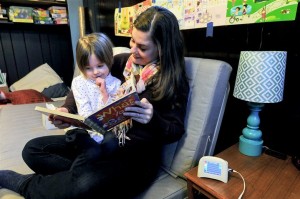CMU creates device, app to monitor home air pollution
From an Article by David Templeton, Pittsburgh Post-Gazette, January 10, 2016
When her son was diagnosed with leukemia six years ago, Patrice Tomcik said she wanted to protect the 3-year-old from environmental exposures she believed may have contributed to the cancer.
But few options were available to monitor air pollution levels, let alone control them. The Butler County woman was particularly concerned about the proximity of natural gas fracking operations and a compressor station to her home in Adams.
“Early on, what could we do to protect ourselves?” said Ms. Tomcik, 45, married and the mother of two sons. The only real option was AirNow.org, which provides regional pollution levels online every half hour.
In response to the concern, Carnegie Mellon University developed Speck, a fine particulate pollution monitor that provides fairly accurate readings of fine particle levels (known as PM2.5 levels) and shows rising or falling pollution levels.
Illah Nourbakhsh, a university professor of robotics, led the CMU Robotic Institute’s CREATE Lab in developing the affordable air quality monitor in 2014. He faced a similar situation in his own home with his children having coughing spells at night that could be halted only by using an air purifier.
Speck is available for $200 through the Pittsburgh spinoff company, Airviz Inc., at www.specksensor.com/. Various local organizations are distributing monitors regionwide and beyond as a new tool to keep close track of air quality so people can react more quickly to reduce health risks from polluted air inside their homes.
More recently, the team developed the newly available smartphone app, SpeckSensor, which provides up-to-date Air Quality Index readouts from the closest air-pollution monitor, based on ZIP code. The app can be programmed to provide air-quality readings from multiple ZIP codes nationwide for those wishing to track pollution levels for friends or family.
An Android version of the SpeckSensor app can be downloaded at Google Play, and an iOS version is available through the iTunes Store.
“There are so many people with asthma or a heart condition who need to track air quality,” said Mr. Nourbakhsh, who holds a doctorate in computer science.
Pittsburgh pollution levels are among the worst in the nation. Fine particulate matter, which comes from combustion of fossil fuels, travels deep into the lungs, raising health risks including heart and bronchial disease, asthma attacks and lung cancer.
Southwestern Pennsylvania continues to have some of the nation’s worst PM2.5 levels, but few residents realize that by peering into the sky. But blurred horizons provide a hint of the problem, even with blue, sunny skies.
Heinz Endowments through its Breathe Project and the Pittsburgh Foundation purchased 1,000 Speck devices they made available through public libraries, schools and citizen groups throughout the Pittsburgh area.
The Southwestern Pennsylvania Environmental Health Project based in Peters now has 240 Speck monitors it provides people in gas fields in four states. It’s systematically gathering home-based particulate levels indoors and outdoors with its nurse practitioner Lenore Resick collecting health information from residents with monitors.
“So far we have seen respiratory issues closer to the well sites,” said Ryan Grode, an environmental health educator with the project. “The more gas, the more respiratory problems.” The group, he said, also has documented increases in headaches, dizziness and even nausea with a link to higher particulate levels.
Spikes in particulate levels can’t be traced to well pads, he said. But when residents are sleeping or away from home, higher particulate levels more likely are linked to gas-well operations, he said.
“What we do know is that higher readings in homes should be looked at and people should be concerned about it,” he said, adding that Speck monitors have proven accurate when compared with government air monitors. “I think Speck is blossoming and more organizations are using it. In time, it will be a really useful tool for a lot of households.”
Ms. Tomcik said her Speck is extremely sensitive to household activities that stir up dust.
“Personally I want to see how things are going in terms of my own air, and I’ve noticed when the kids are playing, they are kicking up dust,” she said. “But it gives people an incredible amount of information. For people who live near unconventional gas well pads, we can monitor the air and see whether the air is safe inside our homes.”
If particulate levels rise for whatever reason, she can open a window or turn on the air purifier. If the air outside is bad, she can close windows.
Jody Handley, 40, who’s concerned about air quality due to allergies, has been testing Speck monitors inside and outside her Squirrel Hill home. High readings often correlate with allergy problems, which she resolves by wearing a mask or clearing the air with an air purifier. She sees levels rise from activities inside the home — while vacuuming floors, making beds or folding clothes, which she said produce lots of dust.
“I’ve been very vocal about improving outdoor air quality,” said Ms. Handley, the mother of two daughters, ages 6 and 4. “We can’t do that, but we can marginally make it better inside our house. That’s important to improve air inside the house for the kids.”

